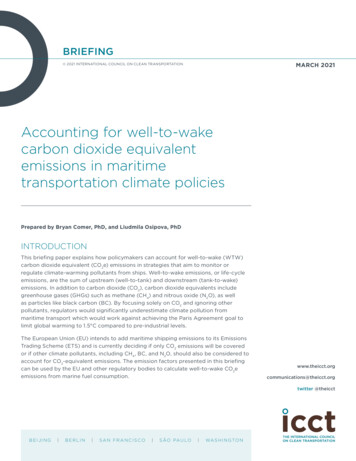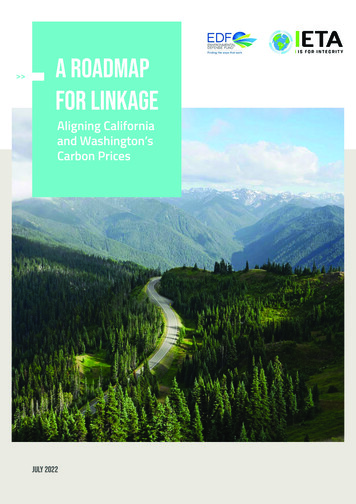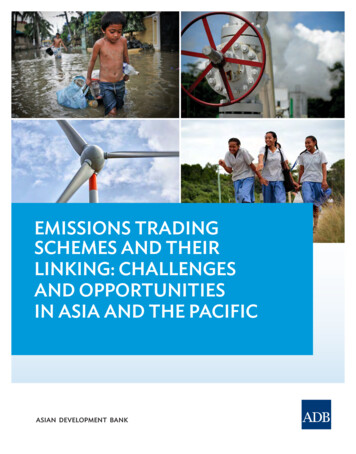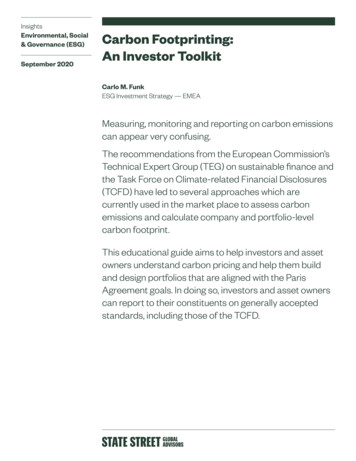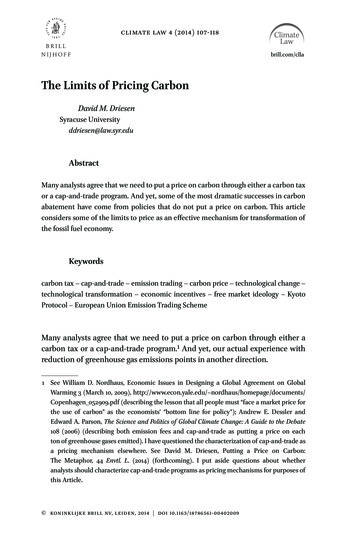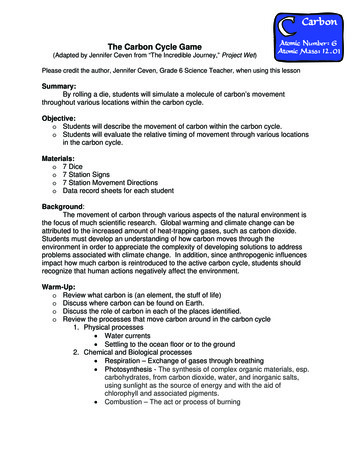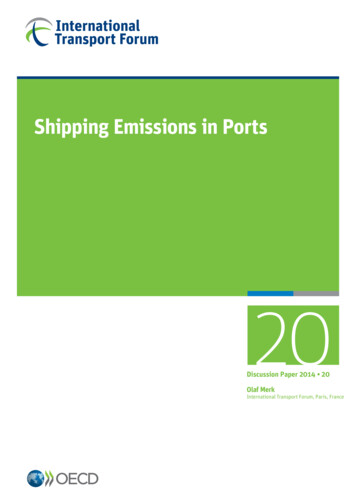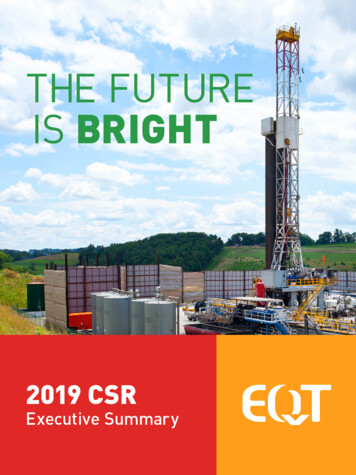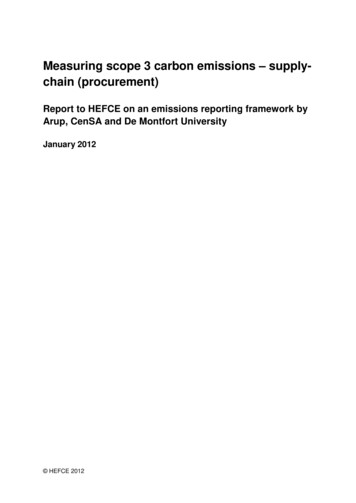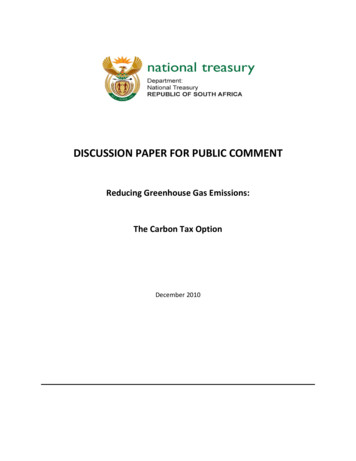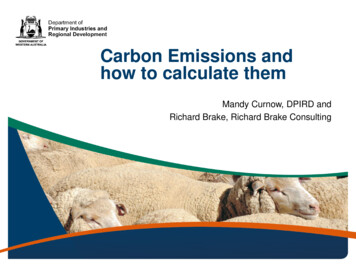
Transcription
Carbon Emissions andhow to calculate themMandy Curnow, DPIRD andRichard Brake, Richard Brake Consulting
MethodsGlobal Warming Potential (GWP) ValuesNot all gases are the same:1 tonne of carbon dioxide CO21 tonne of methane CH41 tonne of nitrous oxide N20 1 tonne of CO2 e28 tonnes of CO2 e265 tonnes of CO2 e-How do we measure Carbon emissions?State and national emission inventories - direct emissions by emission source and sector (eg energy stationary energy, transport fuel)Business/Farm Carbon Accounts include all levels of emissions to the point of export from the farmgate:Scope 1 - emissions that occur on site e.g. enteric methane, CO2 from dieselScope 2 - electricity emissionsScope 3 – emissions associated with purchased inputsLife Cycle Analysis – usually from inception including all inputs through to sale of the product,including processing and transport.From 02016%29 1.pdf
State level Emissions SnapshotSectors reported in National Inventory (2019) and WA proportions1 Energy (92%)2 Industrial Processes (5%)3 Agriculture (11%)4 Land Use, Land-Use Change and Forestry (-9%)5 Waste (2%)WA agriculture emissions9,0008,000CO2 e- Gg (x 1000 03.A Enteric Fermentation3.D Agricultural Soils3.G Liming20153.B Manure Management3.F Field Burning of Agricultural Residues3.H Urea Application
National Greenhouse Gas Inventory reportingWA livestock numbers, value and GHG 21997sheep population (x 1000) 2002cattle population (x 1000)Excludes transport and energy emissions as these are captured in energy sector reportingExcludes land use change on farm as these are captured in Land use sector reporting20072012total emissions from livestock (Gg)2017total livestock value x 1MSource: the National GHG Inventory for emissionsDPIRD, ABS for production. Analysis by DPIRDValue ( 1M) GHG emissions (Gg)livestock number (x 1000)30,000
National Greenhouse Gas Inventory reportingCrop emissions and average state yield 901995yield 2000total crop emissions2005Linear (yield)20102015Linear ( total crop emissions)Excludes transport and energy emissions as these are captured in energy sector reportingExcludes land use change on farm as these are captured in Land use sector reportingSource: the National GHG Inventory for emissionsDPIRD, ABS for production. Analysis by DPIRDState yield (t/Ha)est. crop emissions (Gg)2.0
Carbon Accounting at a farm or business levelWe need to measure so we can manage!In 2020 DPIRD ran a carbon account on Katanning Research Facility to:1. Understand our own emissions so we could reduce emissions from akey government asset2. Understand the process and the challenges of reaching CarbonNeutral on a mixed farm3. Provide a place where different techniques for reducing emissionscould be demonstrated and host important research and trials on novelmethods.
Carbon Account - Katanning Research FacilityEmission intensity by land area 1.5t CO2 e- per arable/grazed hectare per yearProportion of emissions from Livestock activities76% plus a portion of ‘other services’
Thank youContact: Mandy Curnow e: mandy.Curnow@dprird.wa.gov.au 08 98928444For copy of the report and other information: nImportant disclaimerThe Chief Executive Officer of the Department of Primary Industries and RegionalDevelopment and the State of Western Australia accept no liability whatsoever by reason ofnegligence or otherwise arising from the use or release of this information or any part of it. State of Western Australia 2021
Richard BrakeRichard Brake Consulting P/L
The Western Australian Department of Primary Industries and Regional Developmentestablished a project to assess the available tools that include livestock and grainproduction in a mixed farm system for a Western Australian agricultural environment aswell as deal with mitigation and sequestration functionality.Reference is to be paid to:- Level of detailed inputs vs simplicity of use- Appropriate inputs and language for Western Australian producers- Value of outputs and useability of outputsAlso required is the Identification of- Strengths and weakness of each tool- Consistency to other tools and calculators- Gaps or shortcomings in calculations or capture of relevant data
Carbon calculators Primary Industries Climate Challenges Centre / University of Melbourne Cool Farm Tool AFI Agrecalc FarmPrint LOOC – C Other proprietary calculators
Evaluated Farm DataCropped area:2,328 haGrazed area:2,484 ha2020 rainfall:455 mmFive-year average rainfall:551 mmAnnual average temperature:16oCSoil type:Predominantly Forest GravelsCrops grown and included:Barley, Canola, OatsFlock size:14,770
Results, tonnes CO2e/yearPICCC GAFAFI FarmGasThe Cool Farm le Farm4725.772190.624955.928505.085095.10
Emissions, tonnes CO2e/year
Variation from average, tonnes CO2e/year
Summary Accuracy of results generated is highly dependent on the quality andaccuracy of data entered into the calculator The amount of information and level of detail required varied across thecalculators Each calculator covered emissions none adequately covered sequestrationespecially soil carbon although some briefly touched on tree plantings Interpretation of results and application, and refining of managementstrategies outside of ERF methodologies is not well understood
Thank youRichard Brake Consulting Pty Ltd0458 416 602@rich brakerichard@richardbrakeconsulting.com.au
Richard Brake Consulting Pty Ltd
Richard Brake Consulting Pty Ltd
Take home messages Carbon emissions provokes emotive responses Markets are likely to require some form of carbon mitigation As a farmer, be proactive Focus on controlling the issues inside the farmgate We know the climate is changing, we see it everydayRichard Brake Consulting Pty Ltd
Extra detail on programs andoutputs
State level Emissions SnapshotSectors reported in National Inventory (2019) and WA proportions1 Energy (92%)2 Industrial Processes (5%)3 Agriculture (11%)4 Land Use, Land-Use Change and Forestry (-9%)5 Waste (2%)WA agriculture emissions9,0008,000CO2 e- Gg (x 1000 03.A Enteric Fermentation3.D Agricultural Soils3.G Liming20153.B Manure Management3.F Field Burning of Agricultural Residues3.H Urea Application* Agriculture emissions excludes transport and energy emissions as these are captured in energy sector reporting
Definitions Enteric fermentationEnteric fermentation is a natural part of the digestive process in ruminant animals such as cattle, sheep, goats, and buffalo.Microbes in the rumen decompose and ferment food, producing methane as a by-product. Calculated by # of animals x class x feedintake x factor for methane Manure managementManure acts as an emission source for both methane and nitrous oxide, and the quantity emitted is linked to environmentalconditions, type of management and composition of the manure. Organic matter and nitrogen content are the main things influencingemission of methane and nitrous oxide, respectively.Calculated by # of animals x feed intake x factor for methane. NO2 for pasture grazing is added in agricultural soils. Agricultural soilsDirect and indirect emissions of nitrous oxide from soils arise from microbial and chemical transformations that produce and consumenitrous oxide in the soil. The transformations involve inorganic nitrogen mainly ammonium, nitrite and nitrate. Nitrogen compoundscan be added to the soil through:a)the application of inorganic nitrogen fertilisersb)the application of animal wastes to pasturesc)the application of crop residuesd)mineralisation due to loss of soil carbon and cultivation of organic soilse)atmospheric nitrogen depositionf)leaching of N from soils and surface runoff, and subsequent denitrification in rivers and estuaries (Areas with evapotranspirationratios less than 0.8 or more than 1 are deemed areas where leaching and runoff occurs). Field burning of residuesThe burning of residual crop material releases CH4, N2O, CO, NOx and NMVOCs into the atmosphere. CO2 is not included in thecalculations as is assumed that an equivalent amount of CO2 was removed by the growing crop. LimingAdding carbonates to soils in the form of lime (eg. calcic limestone (CaCO3 ) or dolomite (CaMg(CO3 )2 )) results in CO2 emissions,as the carbonate reacts with acids in the soil to produce bicarbonate and eventually leading to the production of CO2 and water. Urea applicationAdding urea to soils for fertilisation leads to a loss of the CO2 that was fixed during the manufacturing process. Similar to the reactionfollowing the addition of lime, the bicarbonate that is formed evolves into CO2 and water
Livestock emissions WA6,0005,0004,0003,0002,0001,000019901995Cattle Methane2000Sheep Methane200520102015Manure SheepManure CattleCropping Emissions WA2500GHG emissions (Gg CO2 e-)enteric emissions Gg (1000tonnes) CO2-e7,000200015001000500019901995Direct Soil Emissions2000Indirect Soil Emissions20052010Field Burning of Agricultural Residues2015LimingUrea Application
WA Agriculture emissions(from National Inventory)9,0008,0007,000CO2 e- 920102011total Livestock2012201320142015201620172018total soils and crops(Agricultural soils: portioned 25% livestock 75% crops)Approx 13.6 million Ha of agricultural pastures and crops with 25% livestock and 75% crop land use.Includes all cattle – pastoral and agricultural ( 50:50)Crops include horticulture and grain
WA cropping production and GHG emissions(Ag soils and 000019901995total crop emissions2000total area cropped20052010total tonnage2015Linear (total tonnage)* Excludes transport and energy emissions as these are captured in energy sector reporting
Current Emissions Reduction Fund methods1.2.3.Animal effluent management method 4.Beef cattle herd management methodincreasing the ratio of weight to age of the herd;reducing the average age of the herd;reducing the proportion of unproductive animals in the herd;changing the ratio of livestock classes within the herd to increase total annual liveweight gain of the herdEstimating sequestration of carbon in soil using default values methodConversion to pastureSustainable intensificationStubble retentionMeasurement of soil carbon sequestration in agricultural systems method applying nutrients to the land in the form of a synthetic or non-synthetic fertiliser to address a material deficiency;applying lime to remediate acid soils;applying gypsum to remediate sodic or magnesic soils;undertaking new irrigation;re-establishing or rejuvenating a pasture by seeding;establishing, and permanently maintaining, a pasture where there was previously no pasture, such as on cropland orbare fallow;altering the stocking rate, duration or intensity of grazing;retaining stubble after a crop is harvested;converting from intensive tillage practices to reduced or no tillage practices;modifying landscape or landform features to remediate land;using mechanical means to add or redistribute soil through the soil profile;5.Reducing greenhouse gas emissions in beef cattle through feeding nitrate containing supplements method6.Fertiliser use efficiency in irrigated cotton method7.Reducing greenhouse gas emissions in milking cows through feeding dietary additives method
Katanning livestock enterprise emissions
Katanning cropping enterprise emissions
Potential strategies to reduce livestock emissionsMitigation or sequestration optionReducing carrying capacity and totallivestock numbers by buying inreplacement maiden ewesIntroducing anti-methanogenic feedadditive 3NOPIntroducing anti-methanogenic feedadditive AsparagopsisBreeding more efficient sheep — forfast growth, weaning rates and feedefficiency/low methaneIntroducing anti-methanogeniclegumes, e.g. biserrula% of theemissionprofileTechnicalmitigationpotential% potential% of flock where adoption acrossthe fraction ofapplicableflockEstimatedmitigationpotential for tential reduction of KRF total emissions 32-35% (excluding potential additives)
Potential strategies to reduce crop emissionsStrategyReduce crop by 30% at full NfertiliserChange crop types E at 50% NfertiliserGreater range of tools tocontrol weeds FMore efficient machinery orcontractors with modernmachineryImprove pasture legumecontent prior to crop toreduce N fertiliser% of theemission profileTechnicalmitigationpotential% of operationwhereapplicable% potential adoptionacross the fraction ofoperation whereapplicableEstimatedmitigationpotential forKRF tential reduction of KRF total emissions 6-9%
Soil and pasturesAverage soil organic carbon at KatanningResearch Facility2008201420172020Soil organic carbon (%) top 10cm2.022.312.401.81Estimatedreduction inKRF emissionsMitigation/sequestration optionContingencies and method used to estimate mitigation potentialConduct green and brown manuring withlegumes on 50ha per annum1Assumes green manure yield of 4t DM/ha/yr (based on KRF pasture data). If 40% of yield is carbon 1.6t C/ha. With a 50% degradation rate, this is equal to 3.2t CO2-e /ha times 50ha 160t CO2-e .Requires trialling and further investigation6.5%Apply biochar applied at 1t/ha to 50ha perannum2Assumes 1t/ha application of biochar over 50ha per annum, of which 0.594t C. This amounts to 109tCO2-e /yr. If biochar could be made on KRF, this is an attractive option. Requires trialling and furtherinvestigation4.4%Implement limingSupports livestock options: 1. Increasing pasture production to allow better growth rates and lower(50%) supplementary feeding, and 2. Increasing perennials and/or legume content in pastures4.1%Plant longer season annualsSupports livestock option 1. Increasing pasture production to allow better growth rates and lower (50%)supplementary feeding4.1%Extend the length of pasture in cropping systemimpact on soil C sequestrationAssumes moving from ‘3 years in pasture and 1 year in crop’ to ‘4 years in pasture and 1 year in crop’,which results in an additional 80ha in pasture per annum3 (absolute rate of 0.33t C/ha/yr on averagesequestered by improved pastures compared with cultivated controls)3.9%Better match pasture availability and livestockfeed requirements leading to quicker turnoffBased on turning off stock 2 weeks earlier3.1%Plant anti-methanogenic foragesAssuming 10% reduction in CH4 emissions from sheep due to anti-methanogenic forages only sown on10% of pasture area0.6%Use rotational grazingIncreases in soil organic carbon as a result of rotational grazing are small or nil0.0%Potential reduction of KRF total emissions 12-15% plus additional 11% if biochar and manuring successful
Next steps to achieve zero emissions at 2030DescriptionStrategiesScenario 1Reduce sheep flock to 60% of current (assumes either buying inreplacement adults or maidens), reducing crop to 50% of currentand changing wheat to barley. Planting 70ha of permanentpastures, forages and shrubs and saltbush, 10% new treesChanging the crop type to barley and therotation to 3 years of pasture, 1 year ofcrop. This gives lower N use due to moreand improved pastures, tree planting.Scenario 2Reduce sheep flock to 60% of current (assumes either buying inreplacement adults or maidens). Planting 70ha of permanentpastures and 117ha saltbush and 20% new treesScenario 3Reduce sheep flock to 85% sheep, (assumes moving to Merinoreplacement flock), crop rotation to 2:1Scenario 4Reduce sheep flock to 85% sheep of current (assumes movingto Merino replacement flock), 100% current crop with rotation at1:1. Planting 70ha of permanent pastures and 117ha saltbushand 20% new treesScenario 5Reduce sheep flock to 85% sheep of current (assumes movingto Merino replacement flock), reducing crop to 50% of currentand changing wheat to barley. Planting 70ha of permanentpastures and 117ha saltbush, 20% new treesCurrentBest betscenarioReduce sheep flock to 85% sheep, of current (assumes movingto Merino replacement flock), reducing crop to 50% of currentand changing wheat to barley, using biochar, Asparagopsis andmanuring, Planting 70ha of permanent pastures and 117hasaltbush, 20% new treesChanging the crop type to barley withrotation to 1:1, improving legume contentof pastures. This gives lower N use dueto pasture, improved pastures, treeplantingChanging the crop type to barley and therotation to 2:1. This gives lower N usedue to pasture, improved pastures, treeplantingChanging the crop type to barley,improving legume content of pastures,tree plantingChanging the crop type to barley and therotation to 3:1. This gives lower N usedue to pasture, improved pastures, treeplantingIncreasing ewe flock efficiency, feedsupplement and growth (lamb weight perewe hectare). Changing crop type tobarley and rotation of 3:1. This giveslower N due to improved pasture, morepastures, tree plantingAll scenarios require Asparagopsis supplements in diet of 90% of the flock by 2027
Not all gases are the same: 1 tonne of carbon dioxide CO2 1 tonne of CO2 e- 1 tonne of methane CH4 28 tonnes of CO2 e- 1 tonne of nitrous oxide N20 265 tonnes of CO2 e- How do we measure Carbon emissions? State and national emission inventories - direct emissions by emission source and sector (eg energy -
